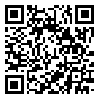Volume 22, Issue 66 (10-2022)
jgs 2022, 22(66): 411-427 |
Back to browse issues page
Download citation:
BibTeX | RIS | EndNote | Medlars | ProCite | Reference Manager | RefWorks
Send citation to:



BibTeX | RIS | EndNote | Medlars | ProCite | Reference Manager | RefWorks
Send citation to:
Haj Agha Mir S M, Reshadat jo H, Abtahi A A, Salehi Amiri S R, Aziz Abadi Farahani F. Explaining the models of cultural tourism development in Iran. jgs 2022; 22 (66) :411-427
URL: http://jgs.khu.ac.ir/article-1-4022-en.html
URL: http://jgs.khu.ac.ir/article-1-4022-en.html
Seyyed Mostafa Haj Agha Mir1 
 , Hamideh Reshadat jo
, Hamideh Reshadat jo 
 2, Ata Allah Abtahi1
2, Ata Allah Abtahi1 
 , Seyyed Reza Salehi Amiri1
, Seyyed Reza Salehi Amiri1 
 , Fatemeh Aziz Abadi Farahani1
, Fatemeh Aziz Abadi Farahani1 


 , Hamideh Reshadat jo
, Hamideh Reshadat jo 
 2, Ata Allah Abtahi1
2, Ata Allah Abtahi1 
 , Seyyed Reza Salehi Amiri1
, Seyyed Reza Salehi Amiri1 
 , Fatemeh Aziz Abadi Farahani1
, Fatemeh Aziz Abadi Farahani1 

1- Faculty of Management and Economics, University of Science and Research, Islamic Azad University of Tehran
2- , Faculty of Management and Economics, University of Science and Research, Islamic Azad University of Tehran , reshadatjoohamideh@gmail.com
2- , Faculty of Management and Economics, University of Science and Research, Islamic Azad University of Tehran , reshadatjoohamideh@gmail.com
Abstract: (1494 Views)
One of the main ways to preserve the traditions and values of the past for future generations is to preserve the culture of the community, which can be addressed by the prosperity of tourism in cities. One of the main ways to preserve the traditions and values of the past for future generations is to preserve the culture of the community, which can be addressed by the prosperity of tourism in cities.The purpose of this study is to explain the models of cultural tourism development in Iran. In the quantitative part of this research, in terms of controlling the studied variables, it is non-experimental, in terms of strategic survey and in terms of the nature of this research is applied. In relation to the research method, it seeks to identify the relationships between cultural tourism and the factors affecting it using the structural equation system. The nature of research is causal research. Considering the application of structural equation modeling to study and analyze the conceptual model of the research, the method of this research is correlational and variance-covariance matrix analysis. The statistical population in the quantitative section was all employees and managers of the Cultural Heritage, Handicrafts and Tourism Organization. In the quantitative part, the sampling method is stratified. Cochran's formula was used to determine the sample size. Based on this, 383 samples were estimated. The tool of this research was a researcher-made questionnaire. To determine the validity and validity of the questionnaire, content validity as well as structural validity were used to determine the validity of the questionnaire. The reliability of the research was analyzed using Cronbach's alpha test. The results of quantitative analysis showed that social indicators have the greatest impact among the leading indicators of cultural tourism in the country.
Send email to the article author
| Rights and permissions | |
 | This work is licensed under a Creative Commons Attribution-NonCommercial 4.0 International License. |





